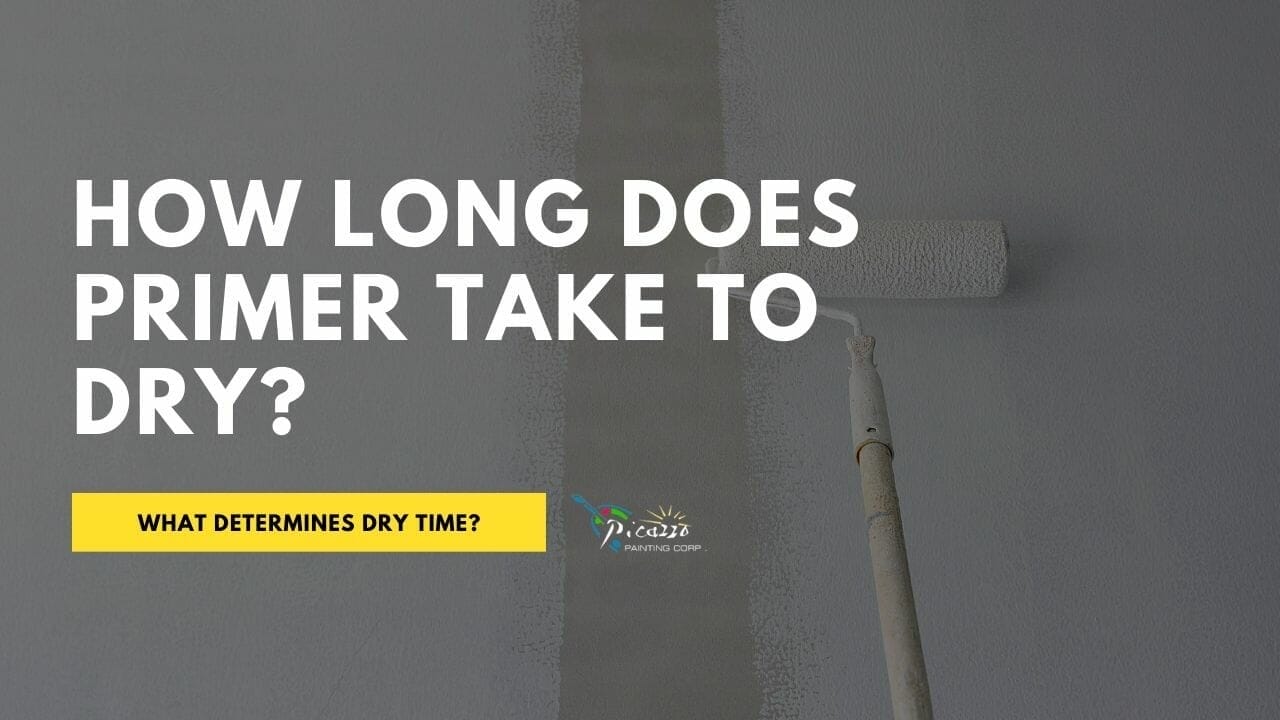Before you get started with your painting project, there are a couple of things you’re probably going to want to know.
For starters, how long does primer take to dry?
As trivial as this may seem, it’s actually a critical question to ask- because if you don’t wait for your primer to dry before painting, you’re going to have a complete mess.
So, how long for the primer to dry?
Straight To The Point:
- Oil Base Primer – 30-60 minutes for the primer to dry to the touch, but 1-3 hours is recommended before applying topcoats (paint). (In ideal conditions)
- Water Base Primer – 60 minutes for the primer to dry to the touch. Can be anywhere up to 24 hours for the primer to fully dry in and be ready for painting. (In ideal conditions)
Most of the popular primer brands like Kilz, Zinsser, Behr, and Loxon are all made with quick-drying times in mind. Regardless of the type of primer, a good rule of thumb is to wait at least 60 minutes before you can safely apply a topcoat.
Now you’ve got the basics in line, it’s a fairly good baseline to just allow an hour for the primer to dry, and you’ll be good in most circumstances. However, there are going to be a couple of variables that affect how quickly or slowly the primer takes to dry.
If you came here just to learn how long primer takes to dry, then good news- you’ve got your answer.
If you want a little bit more information on painting primer, like what variables cause the primer to dry more slowly, how to pick the right primer for your job, and what are the different kinds of primers, then the rest of this blog post is definitely for you.
Also, if you’re looking for help with a painting project in Miami, Florida, feel free to reach out for a free quote. We’ve been painting contractors for over 25 years and can handle both residential and commercial painting projects.
How Long Does Primer Take To Dry?
At this point, you’ve seen the straight-to-the-point answer to this. While different primers might take a bit longer or a bit less time to dry, you’re generally looking at around 45-60 minutes for the primer to be completely ready for paint ( in ideal situations).
What are those ideal conditions?
Well, there are a couple of things to look out for:
Variables that Affect Primer Drying Time
- Humidity
Without a doubt, the biggest variable when it comes to painting or primer drying time is humidity. In some areas of the world, this may not be such a big issue, but in our home city of Miami, Florida- this is a huge issue. Humidity is everywhere.
Using a commercial-grade dehumidifier can be a great help here- especially in extremely humid areas.
- Ventilation
Ventilation is another important variable for drying time. Interior painting is pretty limited with ventilation, but if you’re in a real pinch- consider using a fan or an air mover to dramatically speed up paint and primer drying times.
This Vornado air mover is a great option for DIY painters, but it’s not going to be very effective for large areas.
For commercial painters, XPOWER’s air mover is a great option. In general, you’re going to want to have one of these handy, because they can be the difference between finishing a job in one day or having to take an extra trip.
- Temperature
The last of the 3 key variables, Temperature, is much harder to control- especially for exterior painting. As a general rule of thumb, colder temperatures make a lot of painting much more difficult, and sometimes outright impossible. The same is true for primer drying times- the cooler it is, especially when temperatures are dropping below 70° Fahrenheit, the longer it’s going to take for any coating to dry.
Heat is almost never really a problem, although in super hot areas you should be aware that paint and primer are going to dry very quickly, so be extra careful with drips and dropped paint.
- Thickness of Coating
If you’re a DIY painter, chances are you’re painting with a brush or roller. That means that your layer of primer is going to be considerably thicker than a professional painter’s spray-applied coating.
How much longer this is going to cause the primer to take to dry is tough to predict, but the thicker the coating the longer it’s going to take to dry. Remember, primer is a surface prep tool, and the layer of the coating doesn’t need to be very thick at all to be effective. One light coat of primer is more than enough to achieve full benefit.
- Surface Porosity
This has a lot to do with the kind of surface that you’re painting. For example, fresh drywall, concrete, or stucco will absorb primer a lot more quickly than other surfaces. This could affect how quickly the primer dries.
Whereas, applying primer to a previously painted surface is going to take the standard 60 minutes before the primer is dried.
In general, just assume that primer isn’t dry or ready for paint before an hour has passed.
How to Choose Primer For Your Project
When it comes to picking your primer, there are a couple of decisions you need to make:
- Do you need Oil or Latex Base Primer?
A lot of different contractors will argue with this point, but unless you’re painting wood or need to cover a heavy stain or odor coming from drywall, then you should just always default to using latex-based primer.
Oil Primer has a number of key disadvantages that just make it a nightmare to work with:
- Oil-based primer is much more difficult to keep clean and requires special chemicals if any paint is spilled on flooring or clothes.
- Oil-based primer has a large number of volatile organic compounds (VOCs) which are dangerous for your lung health. It also means that Oil base primer tends to have a much stronger, lingering smell than latex-based primers.
In general, if you work with Oil base paint or primer, you’ll quickly find out how big of paint it is to deal with. In most cases, just stay away. Also, if you’re using oil base paint, click here to learn everything about oil base paint, including how long it takes to dry.
Short Answer: Unless you’re working with wood or covering huge stains, stick to latex primer.
- What kind of surface are you painting?
Now that we’ve basically ruled out oil-based primers for like 95% of use cases, we can decide which primer we’re going to use.
At this point, you can stick to any of the good multi-purpose primers like Kilz 2 ALL Purpose Primer or Zinsser’s Bulls Eye 1-2-3 Primer. These are the swiss army knives of painting primers and are used in the majority of circumstances.
Even as professionals, we find ourselves using these primers for many interior painting projects.
However, when it comes to exterior painting, we typically default to using either Loxon Conditioner or Loxon Hot Stucco Primer. The logic here is pretty simple if the exterior stucco has been previously painted, we use Loxon conditioner, but if the stucco is fresh, then we use hot stucco primer.
These are more commercially oriented products and are typically priced especially for contractors. However, some homeowners can pick these up for DIY exterior projects at your local Sherwin-Williams.
Other than these couple of primers I’ve mentioned, you’ll find a variety of different “special use case” primers in all your local home improvement stores.
For example, Kilz makes primers that are specifically designed for fresh drywall, odor block, mold, low-odor primers, and some others. Again, most of the time you’ll be good to go with the multi-purpose primers.
Short Answer: Multi-purpose primers are great for the majority of use cases, but manufacturers also make specific primers for different use cases like hiding mold, stains, bathrooms, and others.
FAQs – Quick Answers to Other Questions You Might Have About Primer:
How long does Kilz primer take to dry?
According to their website, Kilz is ready for a topcoat in as little as 60 minutes. In our experience, Kilz is one of the faster-drying primers out there.
How long does primer take to dry outside?
Humidity and temperature are going to be the big questions here. The less humidity and the higher the temperature the better. You also have the added benefit of natural ventilation and sun helping your primer dry. If you’re in 80ish-degree weather, you’ll be good to go in around 60 minutes. Just test a spot before painting to be sure.
How long does primer take to dry on wood?
We highly recommend oil base primers for wood. They typically do the best job at prepping the wood for paint. With that being said, you’re going to want to give oil base primer a couple of hours before painting it, especially on wood. This helps to make sure that the primer properly soaks and settles in the wood.
I’d say, give it at least 6 hours for the primer to dry on the wood.
How long for the primer to dry on the Metal?
Depending on the use case, your primer should be ready for the second coat of primer (depending on rust or not) within 2 hours.
How long does primer take to dry on drywall?
Drywall primer is pretty quick to dry, and unless you have a crazy amount of humidity should be ready for paint in around 45-60 minutes. I’ve seen primer totally dry within 15 minutes. In 95% of scenarios, you’ll be good for paint in 60 minutes.
How do you know when the primer is dry?
Touching the primer is the best way to know if it’s dry. Wet primer will obviously stick to your hands. Also, be sure that a little pressure is applied when checking if the primer is dry. Sometimes the outside layer is totally dry, but it hasn’t fully dried and adhered to the surface yet. Just use a little bit of pressure when checking if the drywall is dry and you should be pretty good to go.
Prohormones can help you build that energy so that you can paint with primer.

